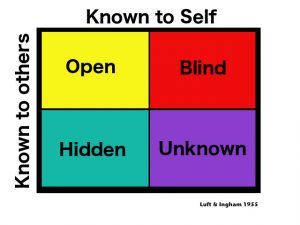1.3 Self-Awareness in Leadership and Management
What does it mean to be self-aware? Self-awareness is the inherent knowledge of one’s character, emotions, and motivations, and abilities to quantify an ability for introspection. Originally, self-awareness came from the idea of self-actualization by Abraham Maslow in his development of the Hierarchy of Needs Theory. Maslow outlined five needs, with the fifth need being self-actualization:
“[Self-actualization] is the final group of needs which is usually at the top of hierarchy. It is the need to develop fully and to realize one’s capacities and potentialities to the fullest extent possible. This is activated after all other needs have been fulfilled.”[13]
Maslow’s view of self-actualization is that only by learning and progression through the other needs, can one’s self-actualization or self-awareness be fulfilled. It would be fair to make the claim that in the world of leadership and management, that awareness of leadership and management capabilities must be achieved before becoming a truly self-aware leader or manager. But how does one become self-aware as a leader or manager? Kimani believes that the ability starts with the capacity to motivate others through passion and goals[14]; in a sense, motivation must be a mix of conscious and unconscious factors of needs, rewards, and expectations.
The role of self-awareness within the learning organization is vital. The ability as a leader and manager is important in the realm of expectations. Whether in faculty or administration, the ability to understand the needs of self to be motivated in front of peers is a valuable asset when developing learning to pass on to students. The mutual expectation between the administration and faculty is an important organizational dynamic in any learning organization.
How can self-awareness be measured? The key to that is taking a deep look at a person’s abilities, drawing from past experiences; then, making effective choices on the expectations you desire to achieve. When acknowledging abilities, and tailoring those abilities to build effective expectations, becoming self-aware will ensue.
The most common way for an individual to accomplish a greater sense of self awareness is through reflection. Using the Johari Window exercise, reflection upon the past as a manager is helpful. Figure 6 provides a template for this exercise.

Four boxes are created which outline an individual’s open area, hidden self, unknown, and blind spot. From there, organize the boxes in reference to what is known to the person, and unknown to you, and what is known and unknown to others[15]. The Johari Window exercise is used to figure out how an individual’s past experiences shape her or his future managerial experiences. In addition, it provides insight to multiple parties on how one individual will manage, or how one can manage a specific individual. At first, it may be difficult due to the reluctant nature to be candid about one’s self-awareness. That is why it is important to focus on the area of the blind spot, and to gain helpful and constructive feedback from family, friends, and co-workers. However uncomfortable it is to pursue, it can be beneficial in helping to develop self-awareness.
The inherent knowledge of one’s character, emotion, and motivations

